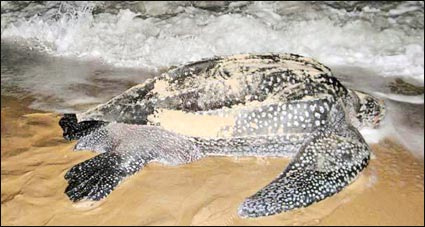Giant turtles
Beach offers a precarious start to life:
POINTE DENIS, Gabon: After two hours
of scouring the beaches of Pongara National Park in the dark night, Joan
Ikoun-Ngossa and his patrol finally find a leatherback turtle
It has just laid its eggs and is struggling awkwardly back to the
sea. For its young, however, there is just a one in a thousand chance of
making it to adulthood, thanks to a deadly combination of humans,
natural predators, pollution and sometimes sheer bad luck.
With the help of a light-coloured red, so as not to dazzle or upset
the turtle Ikoun-Ngossa of Aventures Sans Frontieres (ASF - Adventures
Without Borders) climbs onto the animal to take measurements.
It comes in at 1.6 metres long and 1.11 metres wide.
|

A Luth turtle makes its way back to the surf after laying eggs
on Pointe Denis beach in the Pongara national park on November
18. AFP |
The leatherback is the world's largest species of turtle - they can
live for up to 80 years and reach 2.4 metres in length. However, it is
critically endangered.
After measuring the turtle, Ikoun-Ngossa attaches a ring on its back
leg to track its progress after it leaves the Gabonese coast.
Clumsy and awkward on land, the turtle disappears in a few strokes
once it reaches the water, leaving behind great crawl marks in the sand
like the tyre tracks of a four-wheel-drive.
During the two-month egg-laying season, beginning in October, the
turtles scramble onto the beach at night, dig a hole, lay their eggs
inside and cover them with sand before departing again.
The whole process takes a little less than two hours.
The females lay between 50 and 120 eggs, and one in three is a 'dud',
with no embryo inside, says Ikoun-Ngossa, a former boatman who now works
to protect his country's wildlife.
'The dud eggs are part of the nest. They contribute to regulate the
airflow and temperature, and no doubt nature probably intended them as a
kind of decoy for predators,' he says.
There is no shortage of predators: monitor lizards, crabs and birds,
which are all part of the natural order, but also humans, who sometimes
find and eat the eggs, and dogs which dig them up. 'Of a thousand eggs
laid, we estimate that only one will survive to become an adult turtle,'
said Angela Formia of the Wildlife Conservation Society.
Ikoun-Ngossa stays on the Pongara beaches from October to April to
try to improve the eggs' chances of survival.
'If the turtle lays below the waterline, the eggs have no chance so
we take those ones and put them in a special enclosure' further up the
beach, he said.
This makeshift 'maternity ward' is currently host to more than 300
eggs.
After two or three months, the eggs hatch and the baby turtles, just
a few centimetres long, crawl toward the sea, where many are eaten by
birds, sharks and other predators.
'Currently there are around 40,000 females which come to Gabon, and
this is the largest leatherback turtle population in the world,' Formia
said. Females lay their eggs every two or three years, Ikoun-Ngossa
explains, and study of the tracking devices has shown one turtle can lay
up to three batches of eggs in ten days before swimming off again.
Knowledge of the turtles' lives outside these laying periods is limited.
'The data shows they move to the cold waters in the middle of the
Atlantic and to the south,' Formia said.
'A number have been recorded off the coast of Brazil and Argentina.'
Leatherback turtles play a big role in traditional Gabonese stories.
Legend has it they overcame leopards, snakes and crocodiles through
their cunning.
Today, many observers believe the leatherback turtle is facing
extinction unless more is done to safeguard their welfare.
Courtesy: Dawn.com |



